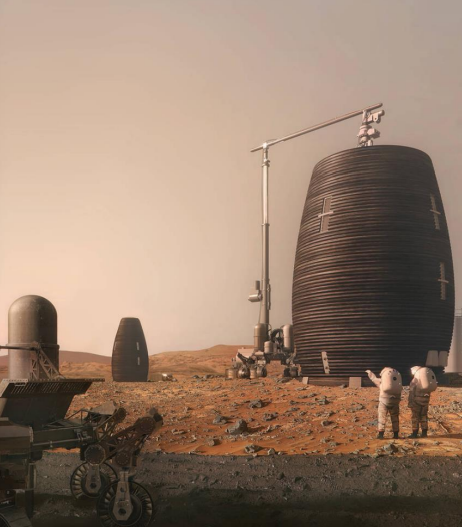In a year dominated by the coronavirus pandemic, it seems difficult to look beyond the outbreak, lockdown measures, and serious consequences to the global economy. Time Magazine even declared 2020 “The Worst Year Ever” on the cover of its December 5 weekly issue. If anything, the global outbreak of COVID-19 and the containment measures deployed by governments had serious consequences. However, amid a tumultuous year that left entire industries looking for disruptive ways to regain momentum and engage operations, one sector rebounded faster than expected. Space companies and startups not only survived the pandemic but saw some of the biggest space missions in years. Moreover, for the expanding space 3D printing market, this meant more additively manufactured parts, machines, and materials leveraging space technology.
Space industry stories published on 3DPrint.com during 2020 reveal one of the most innovative years in the last decade, in line with plans for upcoming space exploration missions to the Moon, Mars, and beyond. Coming to the end of 2020, we picked ten stories that highlight some of the most important advances in the industry going forward.
Made In Space’s First Ceramics 3D Printing In-Orbit
Space-based manufacturing company Made In Space (MIS), now a part of commercial space roll-up Redwire, was the first company to successfully manufacture an object in an off-Earth environment. After launching two 3D printers, a commercial recycler, and an optical ZBLAN fiber payload to the International Space Station (ISS), MIS sent the first ceramic manufacturing facility to orbit on September 29, 2020. Just three months later, the first set of ceramic components was 3D printed.
The Ceramics Manufacturing Module (CMM) demonstrates the viability of manufacturing with pre-ceramic resins in a stereolithography (SLA) environment. It is also a significant milestone for manufacturing in an orbital microgravity environment that could enable temperature-resistant, reinforced ceramic parts with better performance due to a reduction in defects caused by gravity, such as sedimentation and composition gradients that occur in terrestrial manufacturing.
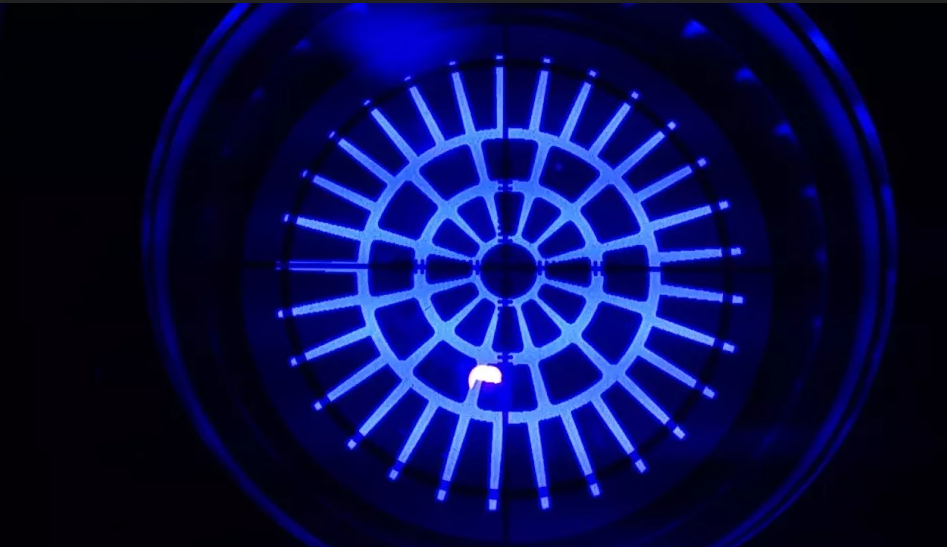
Internal projection of a bladed disk (“blisk”) to be printed by Made In Space’s Ceramic Manufacturing Module.
Image courtesy of Redwire
NASA Advances Novel AM Technique to 3D Print Rocket Engine Parts
On September 11, 2020, we learned that NASA engineers are pioneering methods to print the rocket parts that could power journeys to the Moon and, later on, to Mars, as part of NASA’s Artemis program. As part of the space agency’s Rapid Analysis and Manufacturing Propulsion Technology (RAMPT) project, AM experts are advancing the development of a technique to 3D print rocket engine parts using metal powder and lasers. The method, called blown powder-directed energy deposition, could bring down costs and lead times for producing large, complex engine components like nozzles and combustion chambers, and provides large-scale capabilities that prior developments in AM lacked.
Furthermore, NASA’s Space Launch System program is investing in RAMPT’s blown powder-directed energy deposition fabrication process with the goal of certifying it for spaceflight. Together with RAMPT, the team is using the technique to build and evaluate a channel-cooled nozzle that is up to five feet in diameter and almost seven feet tall.

Blown powder-directed energy deposition can produce large structures, like these engine nozzles, cheaper and quicker than traditional fabrication techniques. Image courtesy of NASA
Blue Origin’s 3D Printed BE-7 Engine Can Land on Moon
After the successful completion of Blue Origin’s fourth BE-7 engine testing at NASA Marshall Space Flight Center on December 4, 2020, company founder Jeff Bezos was quick to announce on social media that his company’s 3D printed engine will not only power the Blue Origin-led National Team Human Landing System (HLS) lunar lander in support of NASA’s Artemis program, but it will be the one taking the first woman to the Moon.
The BE-7 is the latest high-performance engine in the Blue Origin family. A high-performance, additively manufactured liquid oxygen/liquid hydrogen lunar landing engine with 10,000 pound-force (lbf) of thrust – throttling down to 2,000 lbf of thrust for a precise landing on the Moon. As part of a series of validation tests, the latest thrust chamber test measured its ability to extract energy out of the hydrogen and oxygen-cooled combustor segments that power the engine’s turbopumps – the key to achieving high engine performance.
Indian Space Startup Unveils Fully 3D Printed Cryogenic Rocket Engine
In October 2020, Indian space tech startup Skyroot Aerospace unveiled a fully 3D printed cryogenic engine that is meant to fuel the upper stage of the Vikram-II rockets, the startup’s heavier lift launch systems. Called Dhawan-1, the rocket engine is considered India’s first privately developed indigenous fully cryogenic rocket engine that runs on propellants like liquid natural gas (LNG) and liquid oxygen (LoX).
The news came three months after the Union Cabinet led by Prime Minister Narendra Modi took the decision to open up the space sector and enable the participation of the Indian private sector in the entire gamut of space activities. Modi believes that India’s space sector will gain worldwide fame just like its IT industry did some 10 years ago. A fast-growing economy like India could quickly become one of the key players in the space commercialization race, slated to revolutionize the off-planet economy.
Rocket Lab Successfully Recovers Booster for First Time
New Zealand–based launch service provider Rocket Lab successfully recovered the first stage of its Electron launch vehicle for the first time. Developing reusable rocket technology is among the priorities of space companies, making access to space easier, faster, and more cost-effective. The startup, which uses 3D printing for its rockets’ primary components, launched its 16th Electron mission on November 19, 2020, and its largest satellite payload to date on a single trip. Just a few hours later, it recovered the first of its two-stage rocket after a controlled splashdown on the Pacific Ocean. The stage not only survived the trip from space in very good shape, but the feat means the company is on track to reusable 3D printed rockets, so it’s onto the next one. In early 2021, Rocket Lab will launch another recovery mission, opening up a new era of possibility for satellites in orbit.

Rocket Lab recovered the first stage of its Electron booster for the first time ever during the “Return to Sender” mission. Image courtesy of Rocket Lab via Twitter
China Launches Rocket to Mars with 50 3D Printed Parts
Taking the first step in its planetary exploration of the solar system, China sent a Long March 5 rocket to Mars on July 23, 2020. Not only is this its first launch vehicle designed from the ground up to focus on non-hypergolic liquid rocket propellants, but it also incorporates additively manufactured parts. Local 3D printing system supplier Farsoon Technologies used a laser sintering platform and high-performance polymer powder material to produce 50 parts for the rocket’s static firing skirt, which provides a temporary structural medium between the stage and the aft support ring to protect the unlocking device. Continuous operation of the machine helped accelerate production and reduce manufacturing costs for the high-quality functional final static firing skirt, which was composed of 50 separate 3D printed pieces measuring 370 x 100 x 125 mm each, and produced in just 48 hours, as stated by Farsoon. Once assembled, the pieces made up a cylinder structure measuring 5,000 mm in diameter.
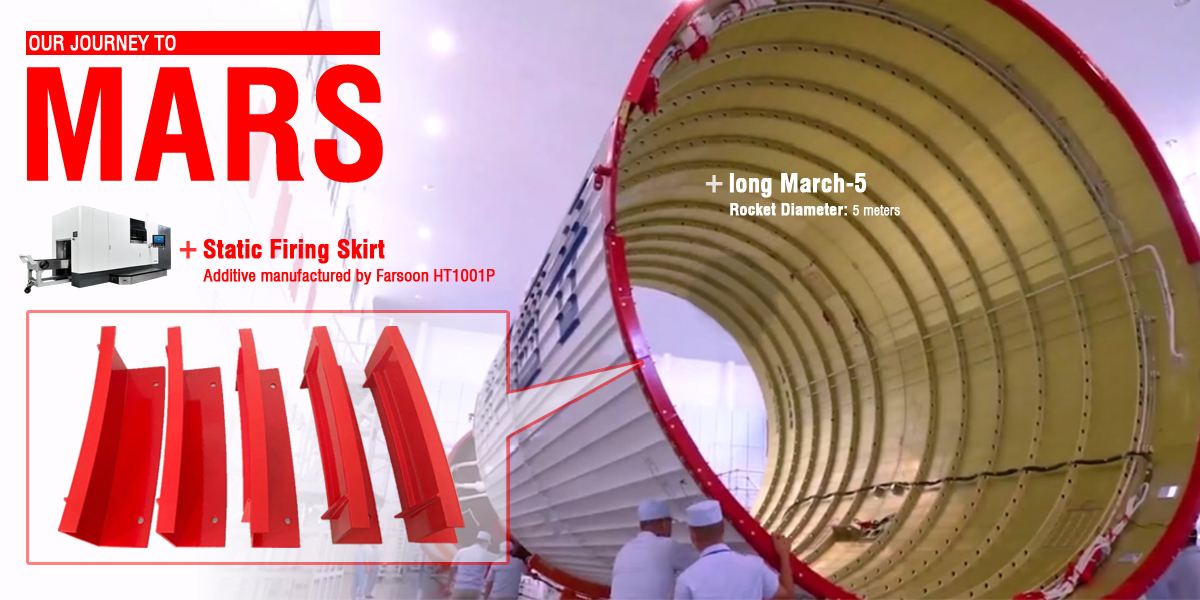
3D printed static firing skirt parts for China’s Long March-5 rocket. Image courtesy of Farsoon Technologies
First Rocket Launch from UK Soil Features 3D Printed Engine
Orbital launch service provider Orbex will be the first company to launch its rocket into orbit at the recently approved Space Hub on Scotland’s northern coast as early as 2022. On June 26, 2020, the UK-based company announced that the go-ahead for Space Hub Sutherland coincided with a period of intensive work at Orbex as design and development work continued throughout the pandemic. Orbex’s innovative space vehicle was conceived and developed as an environmentally sustainable launch system that will use the world’s largest 3D printed rocket engine. Uniquely manufactured in a single piece without joints, seams, or welds, the complex part is expected to withstand extreme temperature and pressure fluctuations while traveling to orbit.
Aerojet Rocketdyne to Make More Rocket Engines with 3D Printed Parts for NASA
As part of a years-long working relationship with NASA, Aerojet Rocketdyne of Sacramento, California, will be building a total of 24 RS-25 rocket engines to support as many as six Space Launch System flights for a total contract value of almost $3.5 billion. Originally slated to produce six new RS-25 engines, the company was awarded in June 2020 a $1.79 billion contract modification to build 18 additional RS-25 rocket engines to support future deep space exploration missions. According to the company, these new engines are an upgrade from the Space Shuttle engines, which were considered among the most reliable ever made. The AM team at Aerojet is using GE Concept Laser and EOS machines for its selective laser melting requirements and superalloys, mostly nickel-based, for the engine parts being 3D printed. Aerojet Rocketdyne may be acquired by Lockheed Martin, making this a big program for the world’s largest defense contractor, as well.
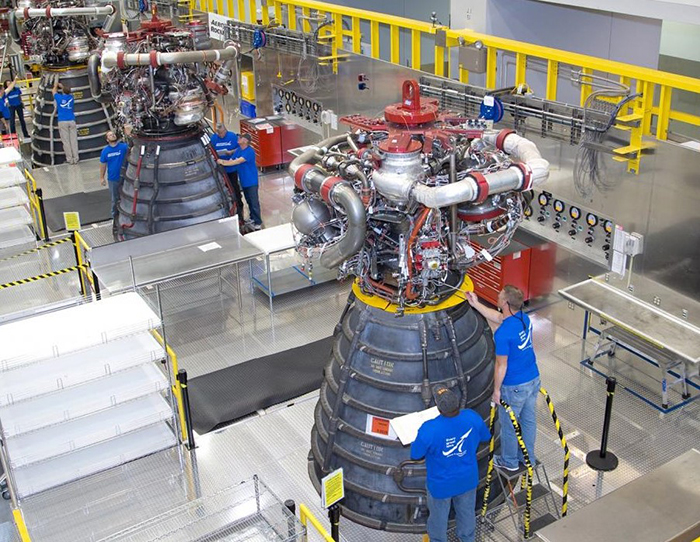
Three RS-25 engines are inspected at Aerojet Rocketdyne’s facility located at NASA’s Stennis Space Center in Mississippi (Credit: Aerojet Rocketdyne)
New Material Will Be Tested for 3D Printing Moon Structures
To the Moon we go in 2024. At least that is the plan set by NASA as part of the Artemis program to send the first woman and next man to the lunar surface in what will be the first landing with humans since 1972. To develop an Artemis Base Camp for long-term exploration, new capabilities will be needed to redefine building constructions on the surface of the Moon. In order to mature new planetary construction technologies, NASA’s Kennedy Space Center in Florida has teamed up with an architectural and construction technology company and winner of NASA’s 3D Printed Habitat Challenge, AI SpaceFactory.
The partnership will lead to the development of a new 3D printing material that uses simulated lunar regolith, which mimics the crushed rock and dust covering the Moon’s surface. AI SpaceFactory and NASA will then use the material to 3D print a test structure in a vacuum chamber simulating environmental conditions on the Moon. The research will help inform how to build structures in other worlds, using technology that relies on in-situ resource utilization (ISRU) to make space exploration more affordable.
NASA’s 3D Printed Rocket Engine Parts Survive 23 Hot-Fire Tests
Through a series of hot-fire tests in November, NASA demonstrated that two additively manufactured engine components – a copper alloy combustion chamber and nozzle made of high-strength hydrogen-resistant alloy – could withstand the same extreme combustion environments that traditionally manufactured metal structures experience in flight. The agency described that these hot-fire tests are a critical step in preparing the hardware for use in future Moon and Mars missions. The ten-day hot-fire tests for a total duration of 280 seconds were a part of NASA’s Long-Life Additive Manufacturing Assembly (LLAMA) project, which aims to enable these 3D printed parts – along with other additively manufactured hardware – for use on future lunar landers.
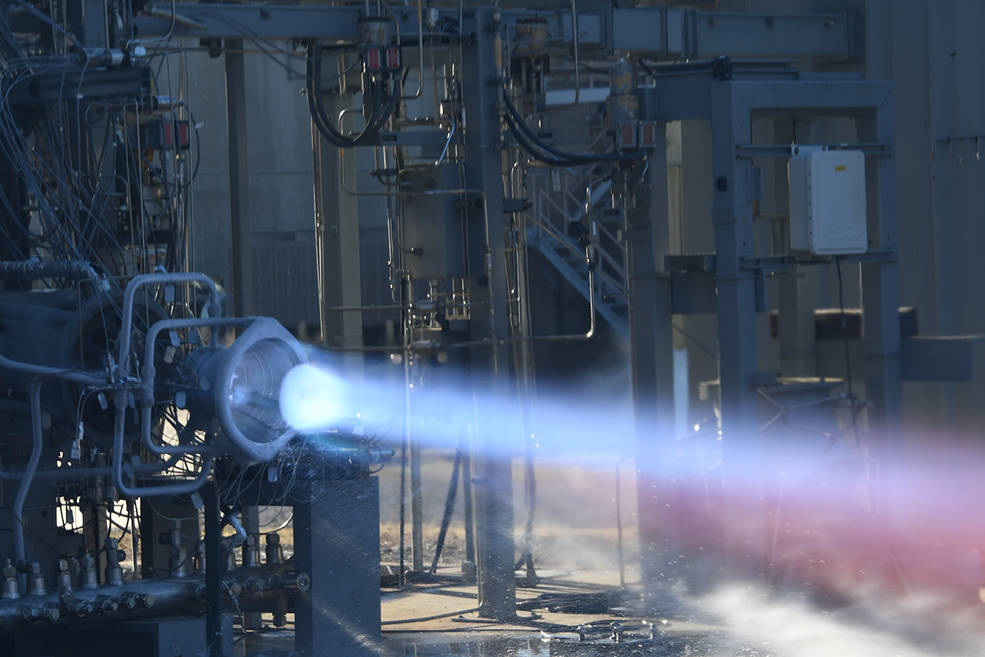
Hot-fire testing of an additively manufactured copper alloy combustion chamber and a nozzle made of a high-strength hydrogen-resistant alloy. Image courtesy of NASA
Subscribe to Our Email Newsletter
Stay up-to-date on all the latest news from the 3D printing industry and receive information and offers from third party vendors.
You May Also Like
3D Printing Financials: Fathom Struggles in Financial Quicksand During Critical Transition
Facing a year of key transitions and financial pressures, Fathom (Nasdaq: FTHM) has filed its annual report for 2023 with the U.S. Securities and Exchange Commission (SEC). The document outlines...
Latest Earnings Overview for Australian 3D Printing Firms Titomic and AML3D
Australian 3D printing manufacturing firms Titomic (ASX: TTT) and AML3D (ASX: AL3) reported their financial results for the period from July to December 2023, marking the first half of their...
3D Printing Webinar and Event Roundup: April 7, 2024
Webinars and events in the 3D printing industry are picking back up this week! Sea-Air-Space is coming to Maryland, and SAE International is sponsoring a 3D Systems webinar about 3D...
3D Printing Financials: Unpacking Farsoon and BLT’s 2023 Performance
In the Chinese 3D printing industry, two companies, Farsoon (SHA: 688433) and Bright Laser Technologies, or BLT (SHA: 688333), have recently unveiled their full-year earnings for 2023. Farsoon reported increases...




